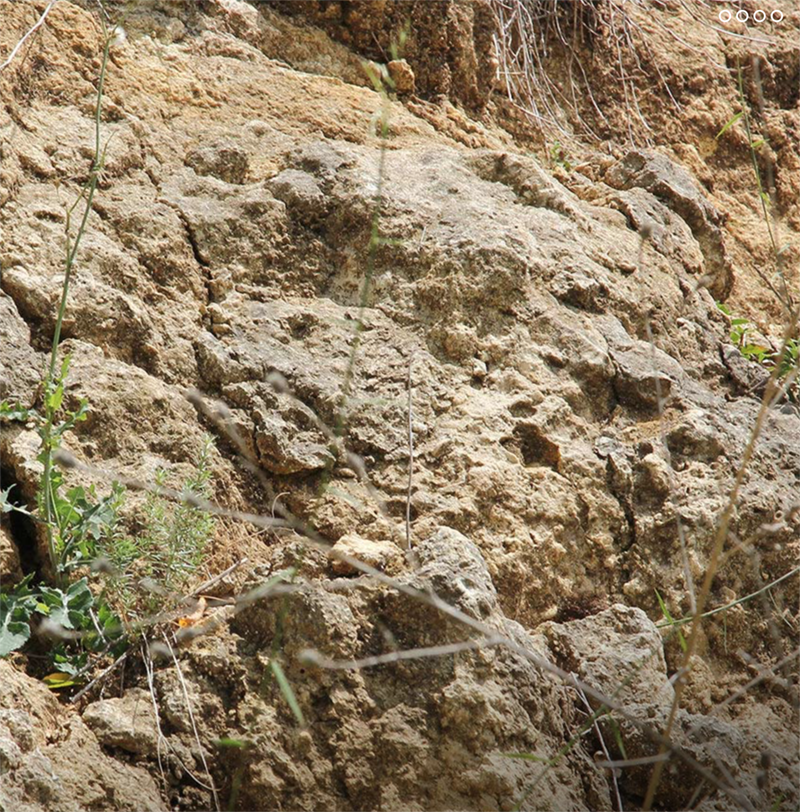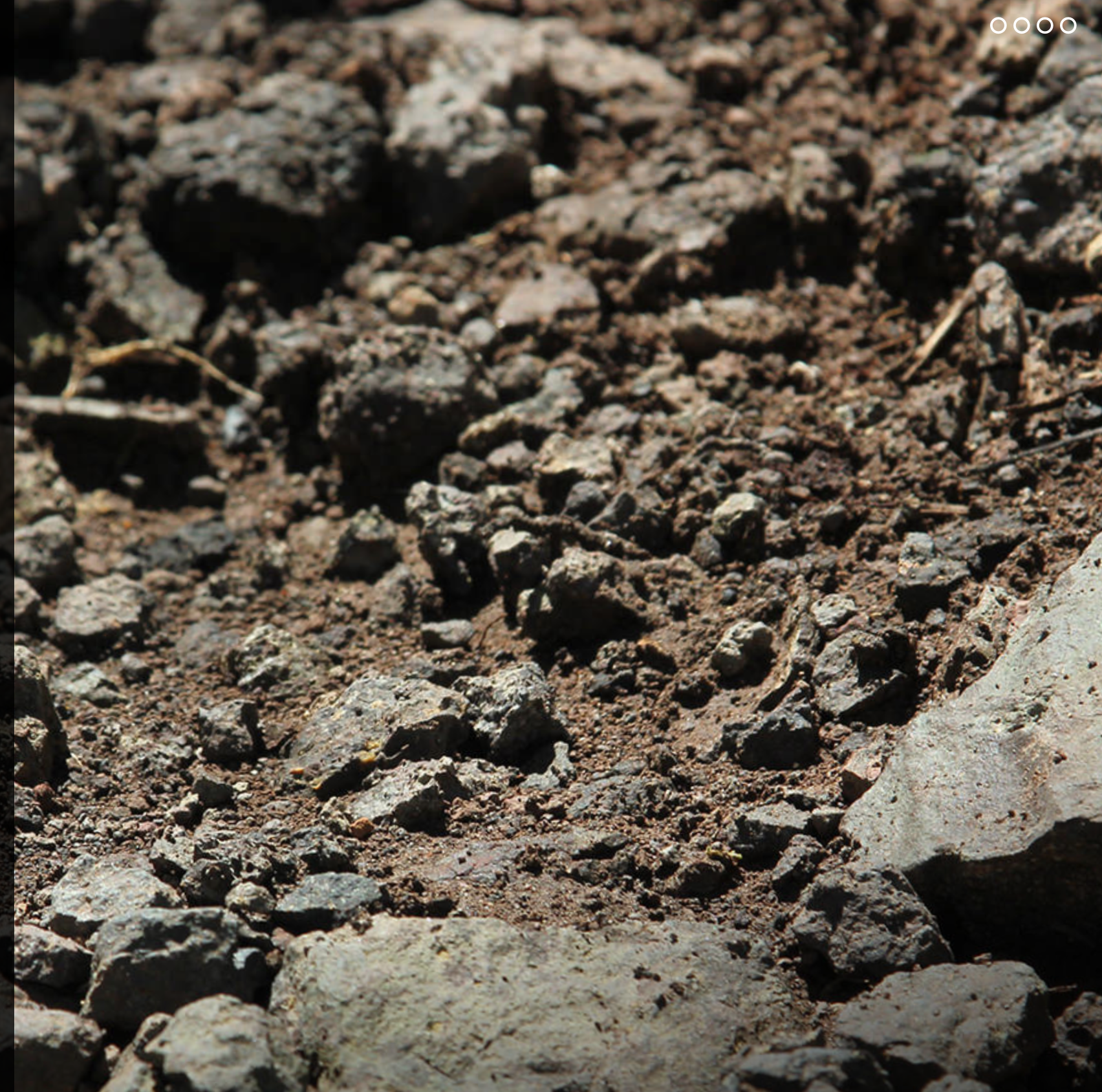Experts agree that the soil in which grapevines grow can have a substantial impact on the grapes’ character. The most basic distinction between soils is their origin: volcanic, sedimentary or metamorphic. Sedimentary soils, particularly limestone and chalk, get a lot attention in the wine world. Volcanic soils can result in equally fine and distinctive wines though.
Of course, origin is just one aspect of soil contributing to a wine’s personality. There is also granularity (eg. clay, silt, gravel), mineral content, decomposed organic content, and water-holding capacity, among others. Volcanic soils are formed in different ways too: slow flowing lava, explosively ejected rock, settling ash, etc. So, even among volcanic soils, there is huge variety. And, since those variations are combined with differing climates, facings, slopes, grape variety, and other considerations, there is no single signature for wines from volcanically derived soils.

Soave Classico soil, primarily volcanic with some pockets of limestone
Typical Attributes of Volcanic Soils
Nonetheless, according to John Szabo, MS, author of the book Volcanic Wines: Salt, Grit and Power, there are several things common to most volcanic soils:
- A wide range of included minerals
- Fairly good balance between those minerals
- Low water retention
- Very low organic content
- Low fertility (due to the scant water and organics)
These features tend to result in grapes which are relatively small, high in acid, and low in ripeness. The small berry size leads to concentrated flavors and pronounced textures. The understated ripeness means the wines are generally more savory than fruity. Salty flavors are common.
Wine Regions with Volcanic Soils
Volcanic activity occurs in three types of places.
- Convergence zones, where two or more tectonic plates are coming together. One plate slides under another, increasing pressure in the magma below. The magma compensates by pushing upward, forming volcanoes. This occurred along the west coasts of North, South and Central America, forming mountain ranges such as the Sierra Madre, Vaca and Cascade.
- Divergence zones, where two or more plates are moving apart. That opens deep fissures which expose the magma below. An example is the mid-Atlantic Ridge, which is mostly underwater, but has created islands such as Iceland and, more importantly to wine lovers, the Azores.
- Hot spots are places in which neither convergence nor divergence occur, yet volcanoes rise anyway. Why this happens remains a matter of debate. Hot spots created the volcanic soils of Tasmania, the Australian island which is a source for excellent, cool-climate wines.
There are scores of wine regions with significant, volcanic pasts. In some cases, such as the Willamette Valley in Oregon, erosion has weathered the craters and flows into innocent-looking hills and plains. In others, such as Mt. Etna in Sicily, eruptions still occur very frequently and the effects on soils are quite obvious.

Soave Classico Calvarino soil (basalt and decomposed basalt)
Regions in which Volcanic Soils Create Distinctive Wines
Napa Valley, especially the eastern, Vaca Range and AVAs such as Howell Mountain, Stags Leap District and Atlas Peak
Sonoma County, especially in the east (Moon Mountain) and the north (Alexander Valley)
Lake County, California
Willamette Valley, Oregon, especially the Dundee Hills and Eola-Amity Hills AVAs
Chile’s Maule and Colchagua Valleys
Mt. Etna in Sicily
Campania, Italy, which includes Naples and is home to Mt. Vesuvius
Soave, Italy, near the northern junction of the African and Eurasian tectonic plates
Santorini, Greece
Golan Heights, Israel
The Azores, off the coast of Portugal
Madeira
The Canary Islands, off the coast of Africa
Somlo, Hungary
Wines from Volcanic Soils
JJ Buckley has many wines from regions with volcanic soils. Here are a few examples.
Cabernet Sauvignon from Howell Mountain
Cabernet Sauvignon and Zinfandel from the Monte Ross Vineyard, Moon Mountain District
Domaine Drouhin Dundee Hills Pinot Noir
Domaine Drouhin Rose Rock Chardonnay
Mt. Etna wines
Pieropan Soave
Stonestreet Chardonnay Upper Barn Vineyard, Alexander Valley
JJ Buckley guest blogger Fred Swan is a San Francisco-based wine writer, educator, and authority on California wines and wineries. His writing appears in The Tasting Panel, SOMM Journal, GuildSomm.com, Daily.SevenFifty.com, PlanetGrape.com, and his own site, FredSwan.Wine (formerly NorCalWine). He teaches at the San Francisco Wine School. Fred’s certifications include WSET Diploma, Certified Sommelier, California Wine Appellation Specialist, Certified Specialist of Wine, French Wine Scholar, Italian Wine Professional, Napa Valley Wine Educator and Level 3 WSET Educator. He's twice been awarded a fellowship by the Symposium for Professional Wine Writers.
Photos courtesy of Pieropan.